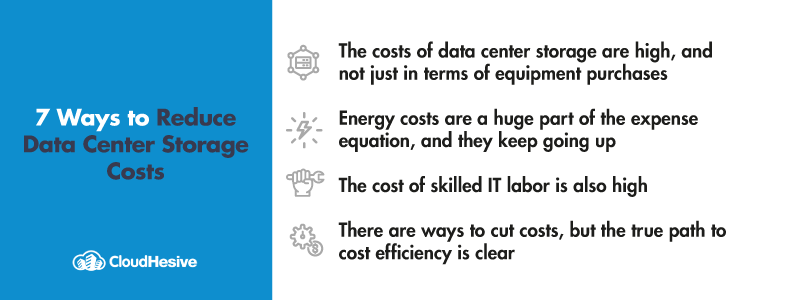For scalability, operational efficiency, and cost savings, there’s only one real answer.

Operating an enterprise data center is expensive. Not only is hardware costly, but power costs can be crippling, accounting for 70% to 80% of the costs of operation (not to mention environmental impact). A lot of electricity is used, but the real energy hog is cooling. Servers generate a great deal of heat. Unless they are cooled continuously, they can shut down or suffer permanent damage.
Then there’s staffing your center 24 hours a day, 365 days a year, and also figuring into data center costs are both facility and infrastructure maintenance and specialized fire suppression equipment. Don’t forget about redundancy techniques – it all adds up at a time when businesses are looking at ways to reduce costs.
Cost reduction has always been part of business, but increases in utility prices, upward wage pressures, and a heightened focus on sustainability have led executives to look at their data center costs. This article looks at seven ways to reduce data center storage costs, the movement to serverless, and how much money you can save by going serverless.
Ways to reduce data center storage costs
Having your own data center gives you complete control over your data. It also means you have complete responsibility for security, which can be a daunting task these days. But costs can be at the forefront of any business owner’s mind. Investigating savings strategies in a physical data center can be tough, but here are viable tips for implementing them to reduce the costs of your data center operations.
1. Right-size your equipment
Data center equipment, by and large, runs most efficiently when they are heavily loaded. This includes servers and cooling systems, so 100% utilization is something to aim for. Can you move loads and shut down some of your infrastructure? This can save money on power and cooling, and the fewer machines to manage, the better.
2. Perform proactive maintenance through monitoring
By using a centralized management system, you can use monitoring and analytics to perform condition-based maintenance. The data identifies patterns that indicate a system failure is imminent, so you can correct it before disaster strikes. This is a vast improvement over crisis management when systems fail, which leads to downtime and reputational damage.
Having a solid data-informed maintenance strategy also beats a regular maintenance schedule recommended by the manufacturer. Money is often wasted by replacing parts that don’t need replacing.
3. Reduce employee turnover
Not only is it difficult to find the right-skilled IT professionals, but salaries are also on the rise. Retaining employees who have a deep understanding of the unique properties of your data center has become imperative. Losing a staffer means losing institutional knowledge as well as needing to search for, hire, and train a replacement. Keep the employees you have, and keep them happy. Pay them well and reward good performance.
4. Provide company-specific training
Your company is unique, and so is your data center, so your staff must know the ins and outs of your situation. Knowing how each piece of equipment operates and relates to each other means your employees have the knowledge needed to extend the useful life of all equipment. Training in standard procedures and emergency actions can reduce downtime, which brings savings.
5. Manage the load properly with automation
It’s vital that your operations team monitors the load in your data center and manages it appropriately. If you have a light load, don’t spread it around – consolidate it. This will conserve energy by reducing cooling capacity. This is a daily exercise that ensures operational efficiency that brings cost savings.
But manual monitoring is slow for process tracking and can delay problem resolution. Event-based automation can both monitor maintenance and update and version data. This gives staff real-time information that can be used to mitigate the effects of adverse incidents. The reports generated by data center automation mean better actionable insights, better regulatory compliance, and increased security.
6. Increase energy efficiency
Data centers consume an incredible amount of electricity. It’s incumbent on data center owners to do what they can to make them more sustainable. Reducing energy consumption takes proper planning, but it can be done.
- Use variable-speed fans. Used in a CPU, variable-speed fans can reduce power consumption by about 20%. Also, take a look at your uninterruptible power supply and any other component that uses a fan.
- Adopt liquid cooling. Using liquid cooling helps your CPUs run cooler, reducing the energy needed to cool the entire center, thereby reducing data center costs.
- Turn up the thermostat. You may be keeping your data center too cold, so raising the ambient temperature can save you some money. Modern equipment can operate at higher temperatures – some up to 77 degrees – so check the manufacturer’s specifications. Of course, any change like this requires close monitoring.
Even with these efforts, it may be too expensive to store your own data. Another option is to move to the cloud.
7. Move to the cloud
Moving workloads to the cloud from a physical data center mean reduced time to market, increased scalability, better reliability, faster recovery, and accelerated innovation. It’s also more sustainable. Data activities, such as storage, sharing, and processing, are transformed. How much money can you save by going serverless? One study found that businesses that move their workloads to the cloud saved 20% overall. Here’s how.
- Reduced labor costs. There’s no more server monitoring nor the need for 24/7 staff. Cloud hardware is managed and monitored by the vendor.
- No maintenance. Again, your cloud vendor has responsibility for any maintenance and repairs. You get a notification that it’s happening so you can back up critical files, and then they take care of the rest.
- No hardware. No more expensive servers and storage devices. Cloud storage means everything is stored online with no need for on-premises equipment.
- Greater efficiency and higher productivity. Data in the cloud is accessible from anywhere, any time.
- Better security. Cloud storage providers know the importance of data security and employ state-of-the-art measures continuously updated by experts.
- Predictable costs and unlimited scalability. Need more space? No problem, and no new hardware purchases. Cloud service providers charge a monthly fee, and you can expand the amount of space you need easily, at any time.
Moving to the cloud can save you tons of money, but as this list shows, that isn’t the only benefit – the cloud offers much more than cost savings.
There are ways to reduce data center costs, but modern organizations are heading to the cloud in droves – 94% of them use cloud services, and 67% of their infrastructure is cloud-based. These companies have seen security improvements, operational improvements, and reduced costs. The preferred cloud platform for many is Amazon Web Services (AWS), the number one global cloud service provider.
Reduce data storage center costs: migrate to AWS
Having your own private data center may make you feel like you’re in control, but its an avalanche of ever-increasing and unpredictable costs can leave your budget in shambles. Spend less, and get more by migrating to the cloud.
CloudHesive is a cloud solutions consulting and managed service provider with expertise in all things Amazon Web Services. We have eight AWS Competencies, over 50 AWS certifications, membership in nine AWS Partner Programs, and the experience and knowledge to help your business realize all the benefits of the AWS cloud.
We’ve helped more than 100 companies reduce their operating costs and increase productivity with our focus on security, reliability, availability, and scalability. With over 30 years of experience, we leverage cloud-based technology to its full potential. Contact the CloudHesive team today.



